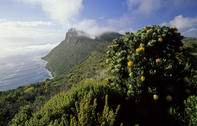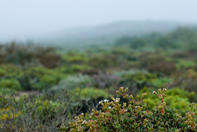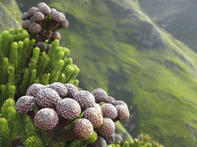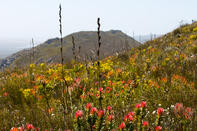Cape Floral Kingdom

The term 'fynbos' comes from the Dutch word 'fijnbosch' used to describe the prickly, narrow leaves of so many of the plants found in the Cape flora. However, the word in no way describes the protea bushes, the few endemic tree species, or the many broadleaved Sandveld and coastal-fynbos shrubs. A more correct, general term is 'Mediterranean sclerophyllous shrublands': Mediterranean for the climatic region, sclerophyllous for the ability of the plants' leaves to withstand the harsh summer conditions prevailing, and shrublands for the obvious reason.
Alternatively, you could say 'Fynbos Biome', which denotes the entire biotic community of these shrublands. 'Cape Floral Kingdom' could also be used - to describe the region's wider floral status - as today, despite its relatively tiny area, the Cape flora is afforded the status of its own floral kingdom, one of six into which the vegetation of the entire planet is divided. Nowhere else on earth is every square metre of ground occupied by such a variety of flowering plants. 'Fynbos' is found on typically sandy, acidic soils, with a low level of nutrients, derived from the widespread Table Mountain Sandstone and more recent coastal sands.
The biome is a nutrient-poor environment as the sand is not only marine in origin, but it has been severely leached over three million years of heavy winter rainfall. Most of the nutrients found in the system are held in the plants themselves rather than in the soil. But still, as anyone who has been there will know, the vegetation is generally too poor to sustain large animals. Even though big game was found at the Cape by early settlers, numbers were low.
Renosterveld and Strandveld

The Renosterveld, named after the plant Elytropappus rhinocerotis, stretches over more fertile, clayey soils derived from granite and shale parent rock, but even this is a degraded veld type, having replaced grass and trees mainly through veld burning and overgrazing. Because the Renosterveld naturally occupies the more fertile valleys and plains, it in turn has been replaced by agriculture and urban expansion and only about nine per cent of the original veld remains.
The Strandveld is the most typically Mediterranean vegetation of the Cape and it grows on coastal soils usually rich in calcium and with a low acidity. This veld type has a high component of Karoo Succulents and it blends into the succulent Karoo veld type along the north-western margin of the fynbos where it is called Sandveld.
Saved from Extinction

The fynbos has had to survive the most stressful of conditions. Summers are dry and can become scorchingly hot, with the relentless south-east wind sucking moisture out of every pore and desiccating both plants and animals. Winters, on the other hand, can bring snow and frequent week-long rain storms that leave the soil waterlogged for most of the season. Yet some of the most beautiful plants in this floral paradise are to be found in the remotest, harshest places among the high, jagged mountain peaks.
The Marsh rose, Orothamnus zeyheri, for instance, grows only on the highest ridges of the Hottentots-Holland Mountains. Not long ago it was thought to have become extinct, until a fire in the Kogelberg area germinated a small, dormant seed bank of the plants and today they have been cultivated at Kirstenbosch National Botanical Gardens, saving it from possible extinction.
Fire and Fynbos

The floral splendour of fynbos is most visible during the years following a veld fire. Some species, often thought by botanists to be long extinct, have the habit of suddenly bursting forth after a fire - species such as the delicate Marsh rose (Orothamnus zeyheri) which is now found in a few small communities on the Kogelberg and Hermanus mountains. Recent successive and widespread fires there, may, however, have endangered their survival.
While regular fires are thought to be good for this fire-adapted vegetation, too-frequent burning is harmful, as trees will not survive regular burns, and some plants, including the larger proteas, need up to 20 years to reach full reproductive maturity. Two burns in 20 years will discourage these species from reproducing, while two fires in less than 10 years will almost certainly obliterate their presence. For this reason, no fires are allowed anywhere in the conservation-controlled fynbos areas - the ecological risks are just too great.
 The Fynbos Route is situated in the Overberg region of the Western Cape province of South Africa. This route takes you into the hidden corne...
The Fynbos Route is situated in the Overberg region of the Western Cape province of South Africa. This route takes you into the hidden corne... Flower season in the Cape is something magical to behold - Experience the beauty of spring wild flowers on The Cape Flower Season Route....
Flower season in the Cape is something magical to behold - Experience the beauty of spring wild flowers on The Cape Flower Season Route....